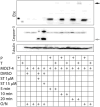The epsilon toxin from Clostridium perfringens stimulates calcium-activated chloride channels, generating extracellular vesicles in Xenopus oocytes
- PMID: 39320019
- PMCID: PMC11423345
- DOI: 10.1002/prp2.70005
The epsilon toxin from Clostridium perfringens stimulates calcium-activated chloride channels, generating extracellular vesicles in Xenopus oocytes
Abstract
The epsilon toxin (Etx) from Clostridium perfringens has been identified as a potential trigger of multiple sclerosis, functioning as a pore-forming toxin that selectively targets cells expressing the plasma membrane (PM) myelin and lymphocyte protein (MAL). Previously, we observed that Etx induces the release of intracellular ATP in sensitive cell lines. Here, we aimed to re-examine the mechanism of action of the toxin and investigate the connection between pore formation and ATP release. We examined the impact of Etx on Xenopus laevis oocytes expressing human MAL. Extracellular ATP was assessed using the luciferin-luciferase reaction. Activation of calcium-activated chloride channels (CaCCs) and a decrease in the PM surface were recorded using the two-electrode voltage-clamp technique. To evaluate intracellular Ca2+ levels and scramblase activity, fluorescent dyes were employed. Extracellular vesicles were imaged using light and electron microscopy, while toxin oligomers were identified through western blots. Etx triggered intracellular Ca2+ mobilization in the Xenopus oocytes expressing hMAL, leading to the activation of CaCCs, ATP release, and a reduction in PM capacitance. The toxin induced the activation of scramblase and, thus, translocated phospholipids from the inner to the outer leaflet of the PM, exposing phosphatidylserine outside in Xenopus oocytes and in an Etx-sensitive cell line. Moreover, Etx caused the formation of extracellular vesicles, not derived from apoptotic bodies, through PM fission. These vesicles carried toxin heptamers and doughnut-like structures in the nanometer size range. In conclusion, ATP release was not directly attributed to the formation of pores in the PM, but to scramblase activity and the formation of extracellular vesicles.
Keywords: TMEM16A; Xenopus laevis oocytes; calcium‐activated chloride channels; epsilon toxin; extracellular vesicles; pore‐forming toxins; scramblase.
© 2024 The Author(s). Pharmacology Research & Perspectives published by British Pharmacological Society and American Society for Pharmacology and Experimental Therapeutics and John Wiley & Sons Ltd.
Conflict of interest statement
The authors declare no conflict of interest.
Figures







Similar articles
-
Epsilon Toxin from Clostridium perfringens Induces the Generation of Extracellular Vesicles in HeLa Cells Overexpressing Myelin and Lymphocyte Protein.Toxins (Basel). 2024 Dec 4;16(12):525. doi: 10.3390/toxins16120525. Toxins (Basel). 2024. PMID: 39728783 Free PMC article.
-
Epsilon toxin from Clostridium perfringens induces cytotoxicity in FRT thyroid epithelial cells.Anaerobe. 2018 Oct;53:43-49. doi: 10.1016/j.anaerobe.2018.05.011. Epub 2018 May 28. Anaerobe. 2018. PMID: 29895394
-
The Cytotoxicity of Epsilon Toxin from Clostridium perfringens on Lymphocytes Is Mediated by MAL Protein Expression.Mol Cell Biol. 2018 Sep 14;38(19):e00086-18. doi: 10.1128/MCB.00086-18. Print 2018 Oct 1. Mol Cell Biol. 2018. PMID: 29987189 Free PMC article.
-
Epsilon toxin: a fascinating pore-forming toxin.FEBS J. 2011 Dec;278(23):4602-15. doi: 10.1111/j.1742-4658.2011.08145.x. Epub 2011 May 25. FEBS J. 2011. PMID: 21535407 Review.
-
Clostridium perfringens epsilon toxin: the third most potent bacterial toxin known.Anaerobe. 2014 Dec;30:102-7. doi: 10.1016/j.anaerobe.2014.08.016. Epub 2014 Sep 16. Anaerobe. 2014. PMID: 25234332 Review.
Cited by
-
Epsilon Toxin from Clostridium perfringens Induces the Generation of Extracellular Vesicles in HeLa Cells Overexpressing Myelin and Lymphocyte Protein.Toxins (Basel). 2024 Dec 4;16(12):525. doi: 10.3390/toxins16120525. Toxins (Basel). 2024. PMID: 39728783 Free PMC article.
References
MeSH terms
Substances
Grants and funding
LinkOut - more resources
Full Text Sources
Research Materials
Miscellaneous

